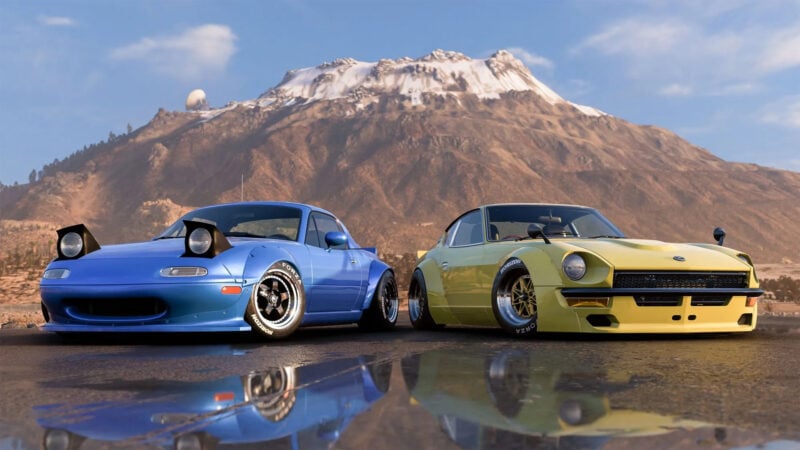
The latest Forza Monthly livestream have given players a decent fill of what’s to come in the new Series beginning next week. While the theme of next week’s festivities wasn’t a particularly well-guarded secret, players no longer have to wonder what awaits them on November 10.
Series 14 will focus on — you guessed it — Donut Media. The star of the show is the five chapter Horizon Story that features a “deep dive into a love cars with James and Nolan”, and also provides a sneak-peek into a brand-new way players will able to upgrade their cars, but more on that later.
Donut Media hosts James Pumphrey and Nolan Sykes will be the voices of the Story, guiding players through the usual Donut Media shenanigans of taking cars to their limits and then some. We’re given a brief into the story, beginning with chapter two and players appears to have three cars to choose from: 1993 Ford Mustang SVT Cobra R, 1993 Nissan 240SX SE, and the 1977 Pontiac Firebird Trans Am.
It’s here that we’re given our first real look into a new feature allowing players to upgrade their cars in real-time using an all-new test track. The new feature will seemingly guide players through understanding what upgrades are beneficial and why.
However the various cars suggested by Pumphrey in the August podcast — Hi and Low Car, Hi and Low Truck, and Money Pit Miata/E36 — aren’t included. It’s worth noting though that S14 won’t be the last we see of Donut Media, so perhaps more is to come…

The Playlist will feature events focused around an odd choice of vehicles for the series spread across the four seasons, and Donut Media will also appear in the names of some of the challenges.
Things kick off in Summer with the #100 Lynk & Co 03 TCR, a 2-liter, turbocharged 4-cylinder touring machine that sends a whopping 350 hp to the front wheels. If the name sounds familiar, it should as the road-going version of the 03 debuted in the “Horizon Road Trip” update only two months ago.
In Autumn, players will be able to secure the Morris Traveler, a car returning from FH4. This estate variant of the classic Mini debuted in 1960 and is powered by a sub-1 liter engine (0.8, to be exact) with a mere 44hp powering the front wheels.
Following that in Winter is another FH4 returnee, the Ford Super Deluxe Station Wagon. Powered by a 3.9-liter V8, the Ford Wagon more than doubles the Morris’s output at 100 hp, though it more than doubles its weight as well.
Finally, there’s the Morris Minor Series II Traveller, yet another returning ride from FH4. With this and the previous two cars, there’s a peculiar theme of wood-paneled cars on offer and we’re not sure how we feel about so much raw automotive appeal being on display.
In addition, Rocket Bunny makes its return to the Horizon series. 21 Rocket Bunny kits, available for 20 cars — two for the FD RX-7, along with various other cars like the 1997 M3, Subaru BRZ and Toyota 86, and a range of Nissans — will be added to the bodykit selection in the game.

Moving on to the more technical side of things, next week’s update will also introduce a host of new features for those on PC. Namely, PC players will finally be able to enjoy ray traced reflections outside of Forzavista mode.
As pictured above, two new presets are making way: Ultra and Extreme. Both options bring ray tracing into photomode, free roam, and races, however, the ultra setting opts for full resolution reflections on the player and AI cars in photo mode, and half resolution for the player car in free roam and race events. Extreme bumps the player car to full resolution in free roam and races.
With this update the game will need more GPU horsepower to run comfortably, but don’t fret as it will also introduce Nvidia DLSS and AMD’s FSR 2.0.
DLSS, or Deep Learning Super Sampling is a technique that renders the game at a lower resolution and uses an AI algorithm to reconstruct the image back to the original resolution. Players will need an Nvidia GPU with Tensor cores (RTX 2000-series and above) to take advantage of this.
FSR, or FidelityFX Super Resolution achieves much of the same result without relying on dedicated hardware or AI reconstruction. As a result, FSR can be enabled on any GPU and achieves very similar results.
The update will also include Nvidia’s DLAA, Deep Learning Anti-Aliasing, which utilizes an AI algorithm to get rid of jagged edges at the game’s native resolution without the need to down or upscale the image — though it cannot be used in tandem with DLSS.
This will all go live when the update arrives on Tuesday November 8.
See more articles on Forza Horizon 5 Game Updates.









